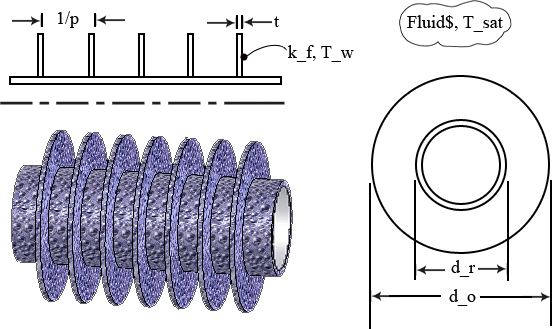Contents
- Index
Cond_Finned_Tube

Procedure Cond_finned_tube(Fluid$, d_r, d_o, t, p, T_w, T_sat, k_f:h_m) calculates the heat transfer coefficient for condensation on a finned horizontal tube in quiescent saturated vapor.
Inputs:
Fluid$ - string variable representing a fluid/vapor in the EES data base.
d_r - root diameter of the finned tube [m] or [ft]
d_o - outer diameter of the annular fins [m] or [ft]
t - fin thickness [m] or [ft]
p - fin pitch in [1/m] or [1/ft]
T_w - temperature of the plate in [C], [K], [F], or [R].
T_sat - saturation temperature of the bulk vapor in [C], [K], [F], or [R].
k_f - thermal conductivity of the fins [W/m-K] or [Btu/hr-ft-R]
Outputs:
h_m - mean heat transfer coefficient in [W/m^2-K] or [Btu/hr-ft^2-R]
Notes:
This procedure is responsible for determining the property data of the fluid specified. The latent heat of evaporation is modified based on the correction term developed by Rohsenow (1956). This correction term accounts for the nonlinearity of the temperature profile due to convection effects. The function Cond_Finned_Tube uses the Beatty and Katz (1948) correlation. This correlation completely neglects surface tension effects, and tends to overpredict the heat transfer coefficient for high surface tension fluids. In addition, condensation along the edge of the fins is not considered. Cond_finned_tube calls fin efficiency.hlpeta_fin_annular_rect to determine the fin efficiency which is then used to determine the heat transfer coefficient in an iterative process as described in section 7.4.3 of Nellis and Klein.
Example:
$UnitSystem SI C Pa J
Fluid$='water'
d_r=0.05 [m]
d_o=0.12 [m]
t=0.003 [m]
p=200 [1/m]
T_w=50 [C]
T_sat=100 [C]
k_f=200 [W/m-K]
call Cond_finned_tube(Fluid$, d_r, d_o, t, p, T_w, T_sat, k_f:h_m)
{Solution: h_m=7102 [W/m^2-K]}
Condensation Index
